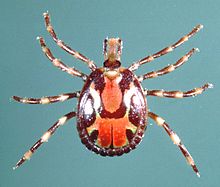| Amblyomma variegatum | |
|---|---|

| |
| A male of Amblyomma variegatum | |
| Scientific classification | |
| Domain: | Eukaryota |
| Kingdom: | Animalia |
| Phylum: | Arthropoda |
| Subphylum: | Chelicerata |
| Class: | Arachnida |
| Order: | Ixodida |
| Family: | Ixodidae |
| Genus: | Amblyomma |
| Species: | A. variegatum |
| Binomial name | |
| Amblyomma variegatum (Fabricius, 1794) | |
Amblyomma variegatum, commonly known as the tropical bont tick, is a species of tick of the genus Amblyomma endemic to Africa. It has spread from its centre of origin to several countries, including the Caribbean islands, where it is known as the Senegalese tick (due to the suspected introduction of the tick from cattle imports from that country) and the Antigua gold tick. They are vividly coloured (especially the males) and have a substantial impact on livestock, primarily through their transmission of diseases. They are three-host hard ticks (where each life stage completes a blood meal on a particular host before dropping off and ecdysis) that have been found on a variety of domesticated species such as camels, cattle, goats, sheep, dogs, and various species of wildlife.
Control
Control programmes have not fared as well as for Rhipicephalus (Boophilus) spp. due to the wider host range. Kelly et al. 2014 obtained good results using livestock tags impregnated with an attraction-aggregation-attachment pheromone and acaricide. Their method shows promise for use elsewhere, if the problem of thick vegetation accidentally rubbing off the tags can be resolved. Maranga et al. 2003 uses a AAA pheromone very differently, combined with CO2 in a site on the ground instead of on a host. Over the next three hours, 90% of A. variegatum within a close distance had travelled to the attracting site and those further away were somewhat attracted. Combining Maranga's technique with an acaricide protects a corral or feedlot area.
References
- Tania Yonow (1995). "The life-cycle of Amblyomma variegatum (Acari: Ixodidae): a literature synthesis with a view to modeling". International Journal for Parasitology. 25 (9): 1023–1060. doi:10.1016/0020-7519(95)00020-3. PMID 8847166.
- ^ de La Fuente, J.; Kocan, K. M.; Contreras, M. (2015-04-01). "Prevention and control strategies for ticks and pathogen transmission". Revue Scientifique et Technique de l'OIE. 34 (1). O.I.E (World Organisation for Animal Health): 249–264. doi:10.20506/rst.34.1.2357. hdl:10261/283532. ISSN 0253-1933. PMID 26470461.
- ^ Sonenshine, Daniel E. (2006-01-01). "Tick Pheromones And Their Use In Tick Control". Annual Review of Entomology. 51 (1). Annual Reviews: 557–580. doi:10.1146/annurev.ento.51.110104.151150. ISSN 0066-4170. PMID 16332223.
External links
 Media related to Amblyomma variegatum at Wikimedia Commons
Media related to Amblyomma variegatum at Wikimedia Commons- Tropical bont tick, on Featured Creatures website, Department of Entomology and Nematology, University of Florida
- Species Profile - Tropical Bont Tick (Amblyomma variegatum), National Invasive Species Information Center, United States National Agricultural Library.
| Taxon identifiers | |
|---|---|
| Amblyomma variegatum | |